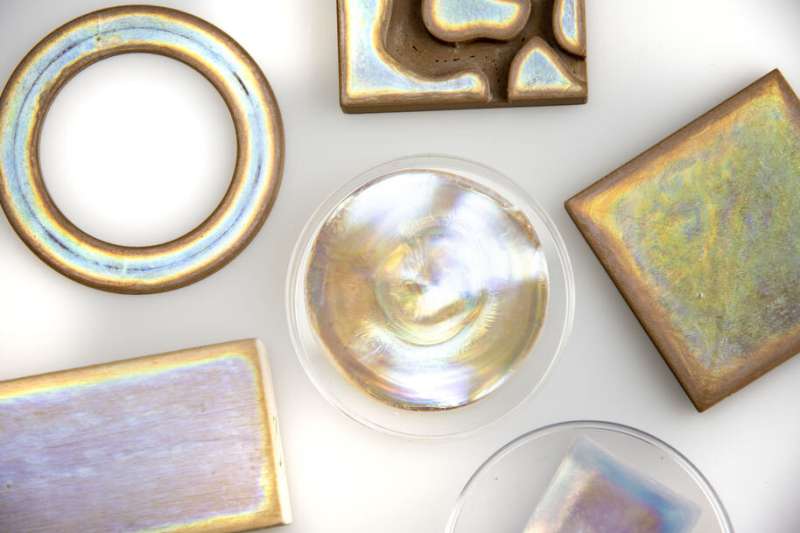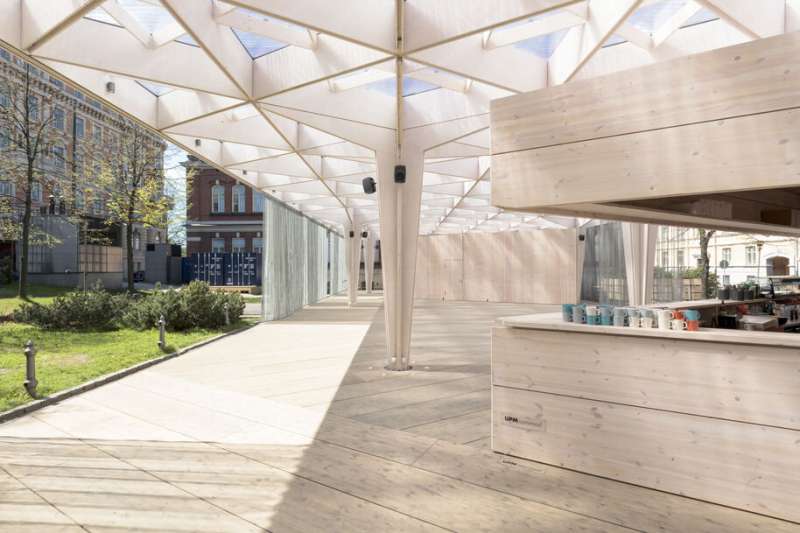Zero-energy house Luukku. Credit: Montse Zamorano
Building wisely with wood is an efficient way to combat climate change. It's possible to build almost anything with wood if we develop our expertise and adjust our attitudes, an expert says.
The built environment gobbles up half of the world's raw materials and generates one-third of all greenhouse gas emissions. For comparison: air traffic accounts for 2.4% of greenhouse gas emissions.
Instead of flight shame, perhaps we should be feeling building shame—or at least looking for more sustainable construction solutions.
A good place to start can be found in the arrivals hall of Helsinki airport, the venue of an Aalto University exhibition called Wood Wonders.
More than a copy
Since February, passengers waiting for their baggage have been able to examine feats of wood construction from furniture to a transitional shelter for emergency zones, and from pavilions to Little Finlandia, a reusable temporary building acting as a partial replacement to Finlandia Hall during its renovation.
It is a fine, finished construction material that grows in our forests with little farmer input and has many as-of-yet unexplored and under-utilised properties, says Pekka Heikkinen, Professor of Wood Architecture and one of the creators of this exhibition.
Finnish home-builders love timber: some 90% of single-family homes are built from wood. Wood accounts for about a fifth of public buildings like schools and daycare centres, but for only five percent of multi-storey buildings.
There's room for growth. Finland's forests produce enough carbon-binding wood to cover the nation's entire annual housing production needs in a single summer day.
But why should we increase wood construction?
The most important reason is the environment, especially the need to fight climate change.
Wood-based structural shimmering wood colour has no colour pigments. Credit: Valeria Azovskaya
The manufacture of building products causes about a tenth of global carbon dioxide emissions, with more than 90% of these emissions associated with the production of steel and cement. Cement is the key ingredient of concrete—and concrete is the world's most used construction material. The suburban building boom of the 1960s made it the norm in Finland, too. A manufacturer of concrete modules and builders to erect them can be found in every city.
The carbon footprint of constructing a concrete multi-storey building is 75% higher than that of a wooden structure. Now, the Finnish government, which has made a commitment to meet demanding climate objectives, wants to double the volume of wood construction over the next four years.
"I hope that wooden buildings aren't made by copying concrete houses; instead, we should exploit wood's good, unique properties and also take account of its limitations," Heikkinen says.
Heat without heating
As a construction material, wood is light, but also durable and strong. The world's tallest wood building is the 18-storey Mjostårnet Tower, which stands 85 metres tall in Brumunddal, Norway. Wooden skyscrapers reaching as high as 300 metres are being planned in Tokyo and London.
Wood is made unique by its other properties.
Housing accounts for up to a quarter of our carbon dioxide emissions. Wood binds moisture and its surface temperature is high, reducing the need for ventilation and heating. Among other things, studies have found that people experience wood-clad spaces as two degrees warmer than spaces, which are exactly as warm but clad with other materials.
Heikkinen emphasises that the effective utilisation of such properties calls for improved expertise and an attitude adjustment.
"So much more time and money is spent on the design of cars than buildings, where the practice is to optimise production by pinching from design. This makes no sense. Good design saves money and the environment by removing spatial waste and creating compact, functional facilities from materials that can be recycled as well."
Among other things, the exhibition showcases the Luukku zero-energy house as well as the modular and movable Kokoon home. Luukku is an interpretation of a traditional Finnish wooden house designed by nearly a hundred-strong group of researchers, students and teachers. Wood has been used all over it, from the air-tight LVL frame to its cellulose insulation, and from the lattice structure of its outer envelope to the wooden cladding and wood-glass composite doors.
In addition to their energy savings potential, wooden structures have another massive advantage. Growing wood binds atmospheric carbon dioxide, which can be stored in wood-based structures for decades, even centuries. The timber structures of the average Finnish wooden single-family home store around 30 tonnes of carbon dioxide. This is equivalent to more than a decade's worth of carbon dioxide emissions by the average motorist.
The Helsinki World Design Capital (WDC) 2012 pavilion enabled many types of events through its physical shape and architecture. Credit: Tuomas Uusheimo
And new, sustainable potential uses are already on the horizon.
Coloured like a butterfly's wings
The biomass that forms wood, lignocellulose, is nature's very own composite material, consisting of water, cellulose, hemicellulose and lignin. Cellulose provides structure, hemicellulose flexibility and lignin serves as the glue that joins it all together.
Industry has for more than a century been cooking cellulose into pulp for the needs of the paper, fibre and packaging sectors. Hemicellulose and lignin are mostly burnt to generate energy.
Lignin can, however, also be used to replace fossil materials and harmful chemicals. For example, Aalto University researchers are developing it into a challenger for formaldehyde-phenolic resin glues, which are needed to make plywood, construction panels and laminated products. Lignin can also be utilised as a natural rustproofing agent as well as raw material for carbon fibres and bioplastics.
Wood has been Finland's green gold for more than a century and the forest industry accounts for a fifth of national exports and directly employs over 42 000 people. By producing higher value-added products, it would be possible to double the value of exports while consuming the same amount of wood.
The exhibition displayed at the airport demonstrates the many potential applications of cellulose. Splicing it into teeny-tiny nanocellulose creates an even lighter, stronger and more malleable material. Researchers mixed nanocellulose, sawdust and colouring agents to make castable wood as well as used nanocellulose to laminate paper sheets into panels with better flexural strength than fibre, plaster or even MDF boards.
But wooden panels that glitter and glow in different hues are the most magnificent example.
Glossy paint colours are usually made with toxic pigments, plastic-based materials or metal membranes. Colours made with nanocellulose contain no colour pigments at all, as colour is instead created by light-reflecting nanostructures, as is the case with some of nature's brightest colours found in peacock feathers or butterfly wings.
The colour is 100% biodegradable, non-toxic and does not fade under sunlight.
Provided by Aalto University


























